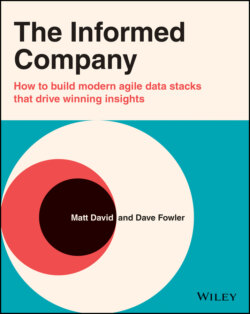Читать книгу The Informed Company - Dave Fowler - Страница 19
Stage 4. Marts
ОглавлениеGood news, your data is clean and the BI product speaks directly with tables in the warehouse. Using a tool like Tableau or Looker, non‐analysts within the organization can self‐serve their questions. By that, we mean they are empowered to engage with the data directly rather than needing to have an analyst build or run queries for them. This is excellent news: more people who use the data become increasingly informed, and everyone across the company can use data to their advantage.
But given enough time, hundreds of tables accumulate in a warehouse. Users become overwhelmed when trying to find relevant data. It's also possible that, depending on the team, department, or use case, different people want to use the same data structured in different ways. So while the meanings of individual fields are unified, the abstractions used by different departments have diverged.
To sort through these challenges, we progress to the data mart stage. These are smaller, more specific sources of truth for a team or topic of investigation. For example, the sales team may only need 12 or so tables from the central warehouse, while the marketing team may need 20 tables—some of them the same, but some different.
Just as a warehouse lead manages data warehouses, data marts benefit from being facilitated by mart leads. The mart lead helps educate and communicate subject matter expertise within the domain of each respective mart while supporting everyday maintenance tasks. Not only will further simplification of data into local marts improve usability, but the integrity of data also becomes easier to maintain. After all, the responsibility of maintenance distributes to mart leads rather than to a single person. The organization that leverages data marts effectively is an example of intra‐company data literacy in action.
